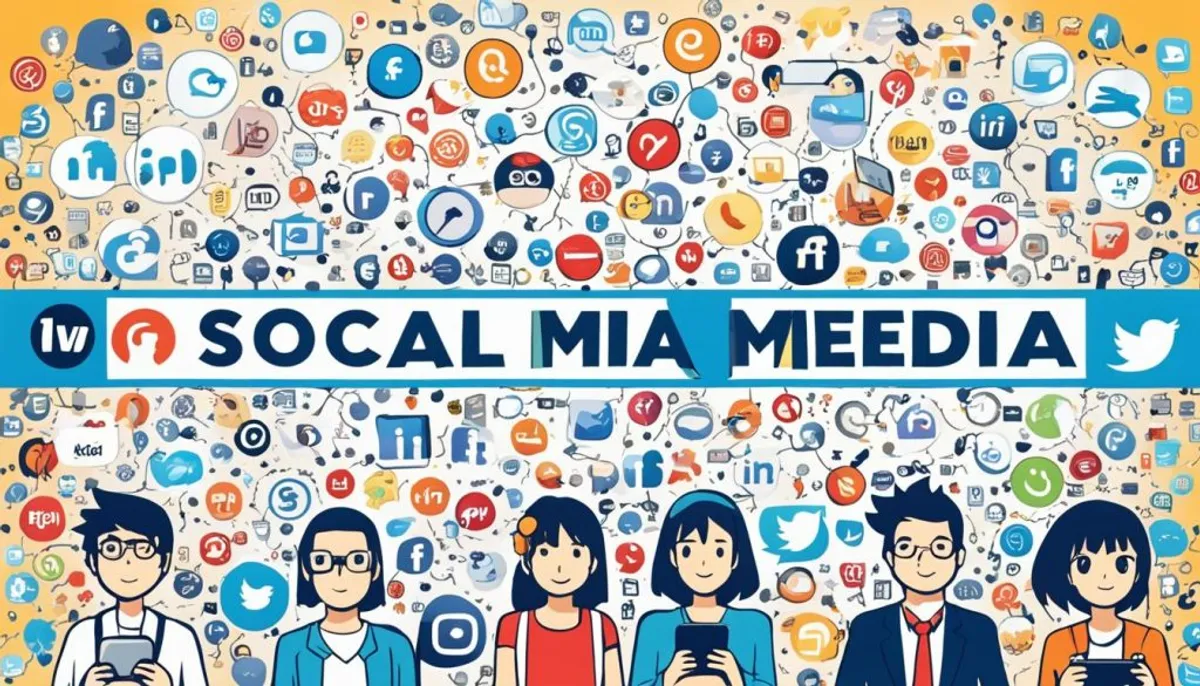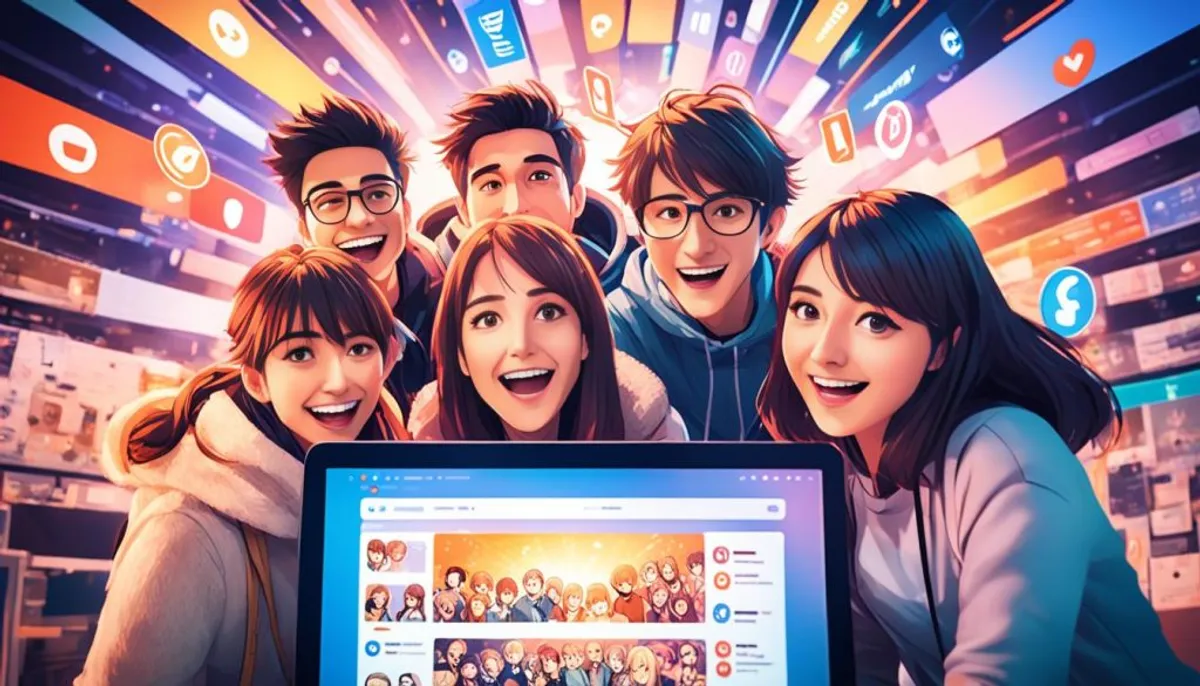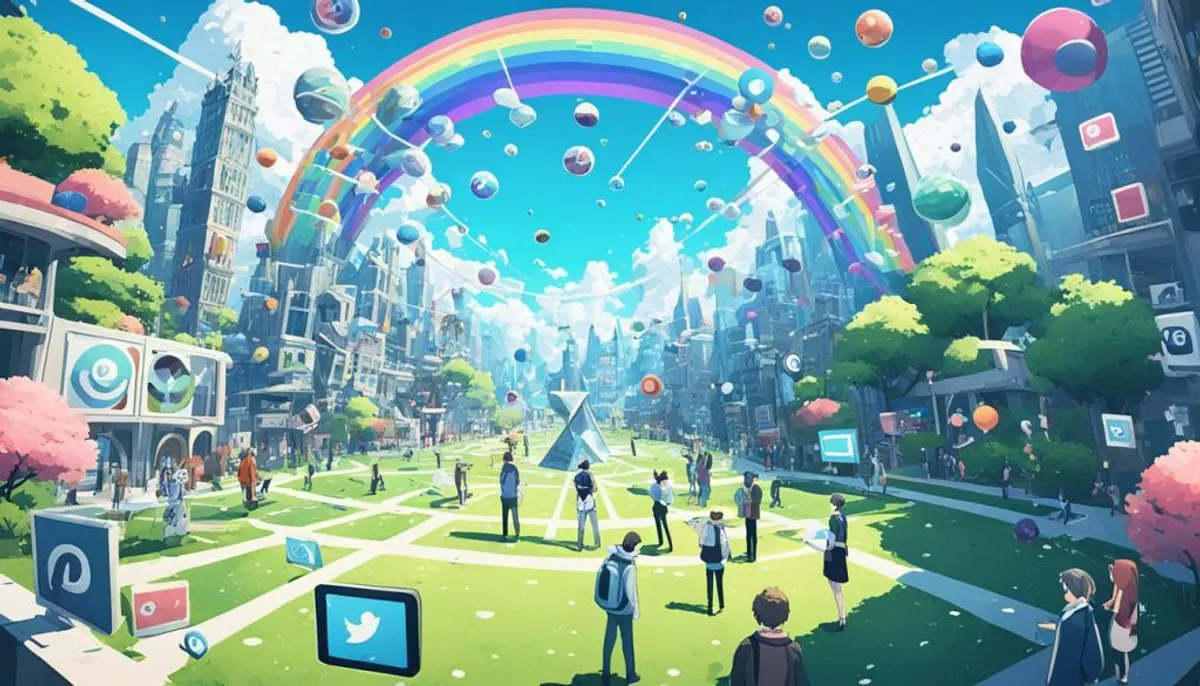Social media has become a huge part of our lives. It lets us connect and share with people everywhere. But when did social media really start? Let’s dive into its history and the moments that made it what it is today.
Merriam-Webster says social media means platforms for sharing and chatting online in communities. It all began with the ARPANET in 1969. This network let scientists at different universities share data and talk to each other.
In the early 2000s, we got the first real social media sites. Six Degrees, Friendster, and MySpace started it all. Then came Facebook, LinkedIn, and Twitter. These sites changed online communication forever, enhancing the musicians and fans connection in unprecedented ways.

Key Takeaways:
- Social media has grown because of new technology and our need to talk to others.
- The ARPANET from 1969 started the social media journey by making sharing and chatting possible.
- Early 2000s platforms like Six Degrees, Friendster, and MySpace helped shape today’s social media.
- Facebook, LinkedIn, and Twitter came next and totally changed how we communicate online.
- Knowing social media’s history helps us understand its role in our lives and what’s next.
Pre-Internet Roots
Social media started before the internet, back in old times. Those years helped social media become big in digital talk.
In 1844, Samuel Morse sent the first digital message with Morse code. It was a big step for future networks that let people share info.
The ARPANET came in 1969, linking universities and research places. It was big for social network history. It let people share data and work together. ARPANET was like a start to today’s internet. It helped social media sites connect us all.
In 1997, Six Degrees started and was an early social network. It let people make profiles and meet others. It helped shape today’s social sites.
“The pre-internet era witnessed the seeds of social media being planted, from the first electronic message to the establishment of interconnected networks. These milestones set the stage for the digital revolution that was yet to come.”
Before the internet, there was still social media. It shows how much we’ve always wanted to connect and talk. It made the social media world we have now. It changes how we talk, share, and engage online.
The Launch of Social Sites
In the late 1990s and early 2000s, digital communication changed forever with the start of social media. These platforms changed how we connect, talk, and share info online. Let’s look at how social media started and the key platforms that helped it grow.
Early Platforms: Six Degrees, Friendster, and MySpace
In 1997, Six Degrees started. It let people make profiles and connect, setting the stage for future sites. Then Friendster came in 2002, quickly becoming popular for making online friends. MySpace, starting in 2003, let users add music and themes to their profiles, making social media even cooler.
The Rise of LinkedIn and Facebook
2002 brought LinkedIn, a place for professionals to network, find jobs, and discuss industry news. Facebook started in 2004, first for college students. It soon took off, thanks to its easy design and mix of social and sharing features. Facebook paved the way for what social media became.
Diversification with Twitter, YouTube, and Instagram
In 2006, Twitter introduced microblogging and updates in just 140 characters or less. YouTube, starting in 2005, became the top site for sharing videos. Then came Instagram in 2010, changing photo sharing with cool filters and easy features.
| Year | Platform |
|---|---|
| 1997 | Six Degrees |
| 2002 | Friendster |
| 2003 | MySpace |
| 2002 | |
| 2004 | |
| 2006 | |
| 2005 | YouTube |
| 2010 |
Platforms like Snapchat and Pinterest have also joined, making social media more diverse. Each new platform made social media more interactive, giving us many ways to connect and share.
The start of social media in the late 1990s and early 2000s built the foundation for today’s social media world. From Six Degrees and Friendster to Facebook and Instagram, social media keeps changing. It connects us more, lets us express ourselves, and keeps evolving.
Modern Social Media Outlets
Nowadays, social media is a big part of our lives. It links billions of people worldwide. These sites have lots of features for different hobbies and goals. This makes social media fun and interesting for everyone. The evolution of social media has transformed how we communicate and interact with each other.
Facebook started in 2004 and is the biggest site with over 2.8 billion monthly users. It’s easy to use, letting people stay in touch, share news, and join groups online.
YouTube is big too, with lots of videos. People go there to find and share all kinds of videos. Instagram lets users post photos and videos, showing their creative side.
Twitter is known for quick updates and chats. Its brief, fast style is perfect for staying current with the world.
“Social media platforms have become powerful tools for connection, self-expression, and information-sharing. They provide an avenue for individuals to engage with a global community and stay up-to-date with the latest trends and news. The evolution of early social media has significantly transformed how we communicate and interact online. However, the rise of social media distraction has made it essential for users to find balance in their online activities. Leveraging live streaming has also emerged as a significant trend, allowing users to interact in real-time and share experiences instantly. Additionally, increasing phishing attacks awareness is crucial as users navigate these platforms, ensuring they can protect themselves from potential threats. Understanding the visual content impact, including gifs and memes, is essential in this digital age, as it influences user engagement and perception. Moreover, discovering viral marketing secrets and effective ppc advertising techniques can enhance how brands connect with their audience effectively. This is where the musicians and fans connection plays a vital role, bridging the gap between artists and their supporters. Furthermore, exploring baidu tieba niche communities can provide unique insights into specific interests and foster deeper connections among users. To gain a competitive edge, businesses are increasingly turning to deep analytics for social media, enabling them to make data-driven decisions and optimize their instagram business strategies. Additionally, using original audio in reels can significantly enhance the appeal of content shared on platforms like Instagram. Understanding the difference between social network and blog is also crucial for users to navigate these platforms effectively. The rise of immersive gameplay in gaming has also influenced social media interactions, as players share their experiences and connect over shared interests. These interactions often lead to various emotional responses to social media, reflecting the impact of digital engagement on users' feelings and behaviors. In this context, linkedin profile optimization has emerged as a transformative force, enhancing security and trust in social media transactions, including transaction fees.”
Others like Reddit offer tons of user-made content and chats in subreddits. Snapchat gives a fun, quick way to share moments with friends through pictures and videos that vanish.
TikTok, which has quickly become popular, specializes in short, fun videos. Its smart algorithm shows videos that match your interests, making it very addictive.
Social Media Platforms Comparison
| Platform Name | Monthly Active Users | Main Features |
|---|---|---|
| 2.8 billion | News feed, profiles, groups, events | |
| YouTube | 2 billion | Video sharing, subscriptions, live streaming |
| 1 billion | Photo and video sharing, stories, Explore | |
| 330 million | Tweets, hashtags, trending topics | |
| 430 million | User-generated content, discussions, subreddits | |
| Snapchat | 280 million | Ephemeral photos and videos, filters |
| TikTok | 800 million | Short-form videos, creative effects |
These platforms don’t just connect people; they also help businesses. They offer ways to advertise and market, reaching potential customers effectively.
Social media is always changing, with new sites and trends on the horizon. The evolution of social media has created exciting opportunities for more chances to connect and share online.
Social Media: End Users and Businesses
Social media has changed how we talk and connect, going beyond borders and time zones. It lets people share info, voice opinions, and have deep talks. With smartphones, staying in touch is easier than ever.
Companies see social media’s value as a marketing tool too. Facebook, Twitter, and LinkedIn let them target ads to the right people. It’s a way for companies to chat with customers, create loyal fans, and increase sales.
There are billions of users on social media, giving all kinds of businesses a chance to reach many people. No matter the size, from small shops to big corporations, all can show what they offer.
Businesses can grow online, boost their brand, and draw in new customers with the right content and marketing. By knowing what people like, companies can make ads that truly speak to their audience. This makes shoppers happy and loyal.
Besides, companies can learn a lot about their buyers through social media. Tools for analyzing data and listening to social chatter help them keep up with trends and what people want. This info helps businesses make smart choices and stay current.
“Social media opens doors for companies to meet their customers and build strong bonds. Using social media smartly helps businesses improve their brand and be competitive.”
Social media is vital for any business’s marketing now. It’s great for customer care, promoting the brand, finding new leads, and making sales. There are many ways companies can succeed online today.
Next, we will look into how social media quickly became a big deal. We’ll see how it’s changing society and making new ways for people to express themselves and connect.
Social Media Statistics
| Platform | Number of Users (in billions) |
|---|---|
| 2.85 | |
| YouTube | 2 |
| 1.22 | |
| 330 | |
| 760 |
The Rise of Social Media
Social media has changed the digital world in a short time. It has grown from small sites to massive networks with billions of users, including Instagram, which boasts impressive instagram monthly active users. Facebook, for example, grew from one million users in 2004 to 2.3 billion by 2019. YouTube, Instagram, and Snapchat have also seen huge growth.
Smartphones and the internet have helped social media grow fast. Now, connecting and sharing online is easier than before. Thanks to better technology, people from all over can join these networks, share content, and talk with others easily.
Social networks let people express themselves and build communities. Users share their lives through photos, videos, and stories. This way, they can keep in touch with friends and family, no matter where they are. Even making new friends becomes easy.
The rise of social media has brought people closer together and revolutionized how we interact, communicate, and collaborate.
Social media is also great for businesses. It helps them connect with customers, promote their brands, and increase sales. With tools like ads, analytics, and influencers, social media gives businesses many ways to grow.
Overall, social media has changed how we talk to each other and how businesses reach customers. It has improved personal connections and opened up new ways for global discussions. As tech gets better, it’ll be interesting to see how social media changes our lives.

The Impact of Social Media
Social media has changed how we connect, communicate, and take part in our world. It affects more than just personal connections and business. It shapes social and political movements, driving change, highlighting the visual content impact on public perception and engagement.
It makes individual and community voices louder. #BlackLivesMatter and #MeToo have shown this power, raising awareness on key social matters. Social platforms allow those less heard to tell their stories, get support, and seek justice.
Social media is a strong force for activism. It helps people join together to push for a better world.
But, social media isn’t all good. It can hurt our mental health, leading to anxiety, depression, and loneliness. Seeing perfect lives online makes us feel less than and unhappy with our own lives.
Privacy and safety online are also big worries. Sharing personal info can risk identity theft and scams. Misinformation is another problem, leading to false beliefs and skewed public views.
Social media has good and bad sides, impacting us and society broadly.
We’re all trying to understand social media’s full effect. This means researching, talking about it, and finding solutions. Everyone must act responsibly online. Social platforms need to protect users, fight false info, and make the internet a healthier place.
The Future of Social Media
The future of social media is packed with excitement as technology grows. Users and new tech trends are molding digital chats. Video content, including live video marketing, and live broadcasts are becoming big. Sites like YouTube and Twitch lead in streaming and making cool videos.
Augmented reality (AR) and virtual reality (VR) will also be big. They will change how we use social media by making virtual spaces. Imagine going to concerts, talking with friends, or seeing new places without leaving home.
But, issues like privacy and security are important too. As social media changes, keeping data safe and fighting cyber dangers are key. This means platforms must work hard to protect us online.
Technology is quickly changing our connection and chats. The future of social media is promising but needs careful thinking.
Businesses and marketers will find new chances in social media’s growth. Staying up to date and tweaking strategies are a must. Using influencers, making personal content, and building communities will be crucial for marketing.
Here is an overview of the future trends in social media:
| Trends | Description |
|---|---|
| Video Content and Live-streaming | Increased focus on interactive and immersive experiences through video and live-streaming. |
| Augmented Reality (AR) and Virtual Reality (VR) | Using AR and VR to provide users with unique and engaging social media experiences. |
| Privacy and Security | Improving user privacy and security measures to protect user data and combat cyber threats. |
| Ethical Use | Ensuring responsible and ethical use of social media platforms. |
| Social Media Marketing | Exploring innovative marketing strategies such as influencer marketing, personalized content, and community-building. |
The future of social media looks thrilling with endless changes. From tech advances to how we like things, social media shapes our connections. Embracing both chances and challenges is key as we step into this digital era.

Conclusion
In the early 2000s, social media started changing how we talk to each other. Sites like Six Degrees, Friendster, and MySpace built the foundation for big names today. Facebook, Twitter, and Instagram have since become key parts of our daily life, changing how we connect and share.
Social media has greatly affected society. It’s a place where people can be themselves, meet others, and push for change. Through viral hashtags and online campaigns, it has amplified important voices, including those of sports icons like cristiano ronaldo.
Looking to the future, social media is set to offer even more ways for us to engage with each other. We can look forward to things like more video content and augmented reality. But, we must also focus on solving problems like privacy and false information. Tackling these challenges will help ensure social media remains a positive force in our communication.
FAQ
When did social media first emerge?
Social media started in the early 2000s. It began with sites like Six Degrees, Friendster, and MySpace.
What are the origins of social media?
Social media’s roots go back to the ARPANET in 1969. This system let scientists share data with each other.
What are some of the earliest social media platforms?
Early social media sites include Six Degrees, Friendster, and MySpace. They all started in the early 2000s.
What are some popular social media networks today?
Today’s top social media sites are Facebook, Instagram, and Twitter. YouTube, LinkedIn, Snapchat, Reddit, and TikTok are also very popular.
How has social media impacted end users and businesses?
Social media changed how we talk to each other. It also gave businesses new ways to reach out and connect with customers.
How has social media evolved over time?
Since it started, social media has grown a lot. Sites like Facebook, Twitter, and Instagram are now well-known. They have billions of users all over the world.
What is the impact of social media?
Social media has a big effect on how we talk, do business, and see the world. It helps people connect, share info, and support social and political causes.
What does the future hold for social media?
The future of social media looks exciting. We might see new things like better video content, augmented reality (AR), and virtual reality (VR).
In summary, what is the birth and evolution of social media?
Social media began in the early 2000s with sites like Six Degrees, Friendster, and MySpace. It has grown fast, changing how we communicate and connect with the world.
RelatedRelated articles



